Sleeping pads are essential gear for any backpacking trip in the Lockyer Valley, providing warmth and comfort under your sleeping bag even on rough ground. If you’re planning a bushwalk or an overnight bush camping adventure in Murphys Creek Escape, having a lightweight, durable sleeping mat or pad can make a big difference in your sleep quality. Whether you prefer a closed-cell foam pad or an ultralight air mat, choosing the right pad will enhance your camping experience.
Best Sleeping Pads for Backpacking in Australia 2025
Thermarest Z-Lite Sol 3 Season Foam Hiking Mat
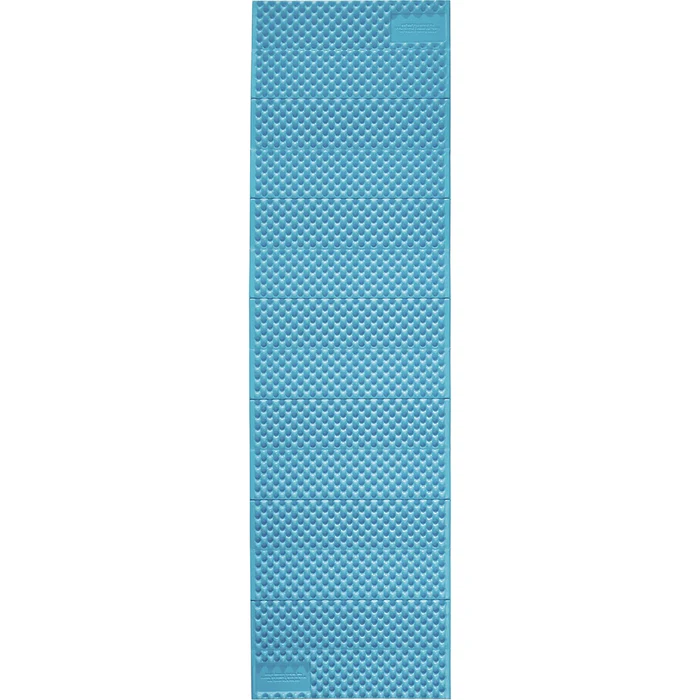
- Weight: ~410 g (Regular)
- R-value: 2.0
- Dimensions: 183 x 51 x 2 cm (Regular)
- Type: Closed-cell foam pad with ThermaCapture reflective coating
Pros:
- Virtually indestructible closed-cell foam pad – no inflation needed.
- Heat-trapping dimples plus a reflective ThermaCapture layer boost warmth by ~15%.
- Accordion-fold design packs compactly; extremely lightweight for durability.
- Affordable and reliable – ideal as a base layer to add insulation on cold nights.
Cons:
- Low R-value (2.0) – suited mainly for 3-season use or as a bottom pad under another pad.
- Only 2 cm thick – minimal cushioning, which may feel thin under hips or on uneven ground.
- Fixed shape (not inflatable) means a rigid pack size.
Best for: Minimalist backpackers and thru-hikers who prioritize durability and weight savings. Also great for bush camping at Murphys where rough ground makes foam preferable. Its hardy construction prevents punctures and works even when damp or cold.
With its high comfort-to-price ratio, the Z-Lite SOL is a favorite among hikers looking to buy a dependable closed-cell foam mat for summer and 3-season trips.
Buy it here > Therm-a-Rest Z Lite Sol
Nemo Switchback Ultralight Sleeping Pad

- Weight: ~415 g (Regular)
- R-value: 2.0 (with thermal film)
- Dimensions: 183 x 51 x 2 cm (Regular)
- Type: Insulated closed-cell foam sleeping pad (dual-density foam with reflective layer)
Pros:
- 20% thicker than many foam mats, offering extra cushioning for side sleepers.
- Hypnoelastic™ zones in dual-density foam conform to your body for ergonomic support.
- Metallized thermal layer reflects heat back to you (adds ~15% warmth).
- Packs down small, durable, and requires no inflation (unfold-and-use convenience).
Cons:
- Heavier than ultra-minimal foam pads due to extra thickness.
- Foam compresses under weight over time (loft decreases on rough ground).
- Only moderate warmth – best for summer/backpacking or layered with another pad.
Best for: Backpackers or campers wanting more comfort from a foam pad. Ideal for side sleepers and anyone who wants quick, inflation-free setup. The Switchback is great for weekend hikes and family camping, where a little extra weight is acceptable for extra cushion.
The Nemo Switchback is highly rated for being good in comfort and lightweight warmth among foam mats.
Buy it here > Nemo Switchback Ultralight Sleeping Pad
Sea to Summit Ultralight SI Sleeping Mat (Large)
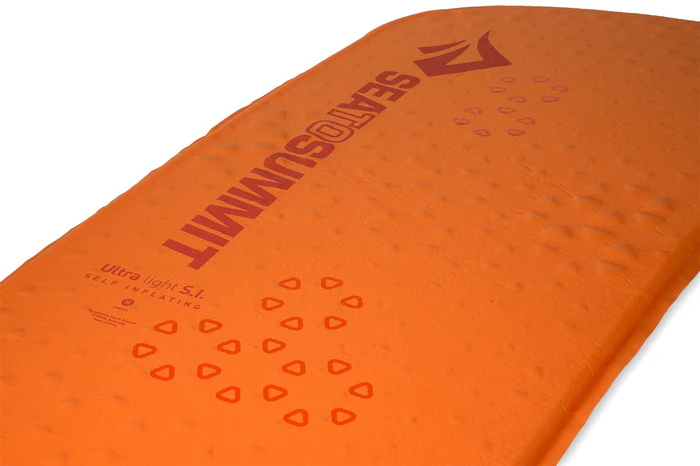
- Weight: 550 g (Large)
- R-value: 2.6 (Thermolite insulation)
- Dimensions: 198 x 64 x 2.5 cm (Large)
- Type: Self-inflating foam sleeping mat (30D nylon cover, polyester foam core)
Pros:
- Self-inflating design (no pump needed) for easy setup.
- Moderate R-value (2.6) provides some warmth for cool 3-season nights.
- Delta Core-V™ tech: foam cores removed from non-contact zones to reduce weight while keeping thickness.
- Anti-slip base and durable finish; decent comfort for a thin foam pad.
Cons:
- Only 2.5 cm thick – feels firmer (less cushion than thick air pads).
- Heavier and bulkier than ultralight air mats of similar insulation.
- Valve must be closed before rolling up to avoid air loss.
Best for: Hikers who want a blend of foam durability and convenience. Good for car camping or overnight trails where pack size isn’t critical. The Large size gives a long, wide surface, and the included insulation helps with warmth.
The Sea to Summit Ultralight SI Sleeping Mat is a great option if you want a packable, comfortable self-inflating pad with built-in insulation.
Buy it here > Sea to Summit Ultralight SI Sleeping Mat
Nemo Tensor Insulated Ultralight Sleeping Pad
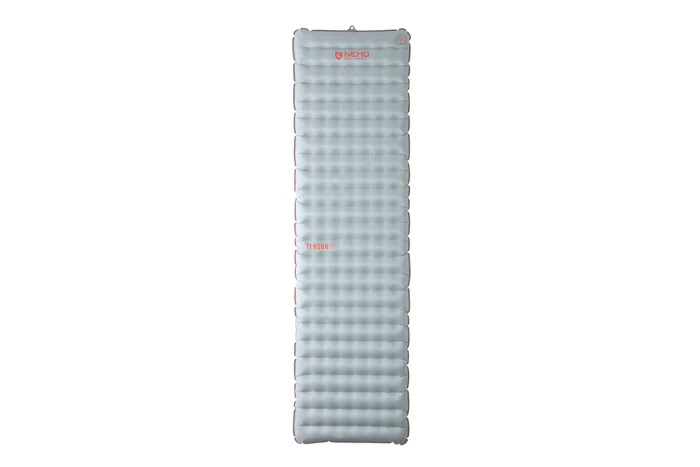
- Weight: 522 g (Regular, All-Season)
- R-value: 5.4 (All-Season model)
- Thickness: 9 cm (3.5 in)
- Type: Inflatable air pad (triangular Spaceframe baffles, ThermaCapture foil)
Pros:
- Exceptional warmth (R5.4) – one of the highest-rated pads for cold-weather camping.
- Very thick and cushioned (3.5 in) for side sleepers, smoothing out rocks and uneven ground.
- Lightweight for its insulation; packs small (useful for winter backpacking).
- Quiet and supportive; winglock valve allows easy inflation and fine-tuning.
Cons:
- At 522 g, heavier than summer-specific pads – not an ultralight choice.
- Premium price tag (high-tech design costs more).
- Fairly large packed size (around 10 × 4 in).
Best for: Winter campers, mountaineers, or anyone needing max warmth in a lightweight package. Perfect for camping in winter. It’s also great for comfort-focused campers who want a plush, warm mattress without carrying a huge weight.
While stock varies, Australian retailers like Wildearth occasionally stock Nemo Tensor (it was named Wildearth’s 2023 Gear of the Year for its warmth). Its combination of insulation and low weight makes it the top pick for cold-weather hiking.
Buy it here > Nemo Tensor Insulated Ultralight Sleeping Pad
Sea to Summit Ether Light XT Insulated Sleeping Mat (Regular)

- Weight: 490 g (Regular)
- R-value: 3.2 (3-season)
- Thickness: 10 cm (4 in)
- Type: Inflatable air pad (Air Sprung Cells + Thermolite insulation)
Pros:
- Very thick (10 cm) for luxurious comfort – each Air Sprung Cell conforms to your body.
- Good insulation (Thermolite + foil gives R3.2) for cool nights.
- Reasonably lightweight and compact for such thickness.
- Fast inflate/deflate WingLock valve allows quick setup and packing.
- Softer, quieter top fabric (70D bottom, 30D top) feels nice against sleeping bag.
Cons:
- Heavier and bulkier than uninsulated ultralight pads (490 g vs ~300 g).
- Not suitable for deep winter (R3.2 only).
- High cost.
Best for: Side sleepers and comfort-seekers on 3-season hikes. It’s excellent for backpackers who want a plush, cushiony pad without a big weight penalty. Perfect for trips where you often camp on cooler nights – it keeps you warmer than regular pads.
The Sea to Summit Ether Light XT Insulated mat is widely recommended for hikers who want an ultra-comfortable pad that still packs down small.
Buy it here > Sea to Summit Ether Light XT Insulated mat
Klymit Insulated Static V Lite Lightweight Sleeping Mat
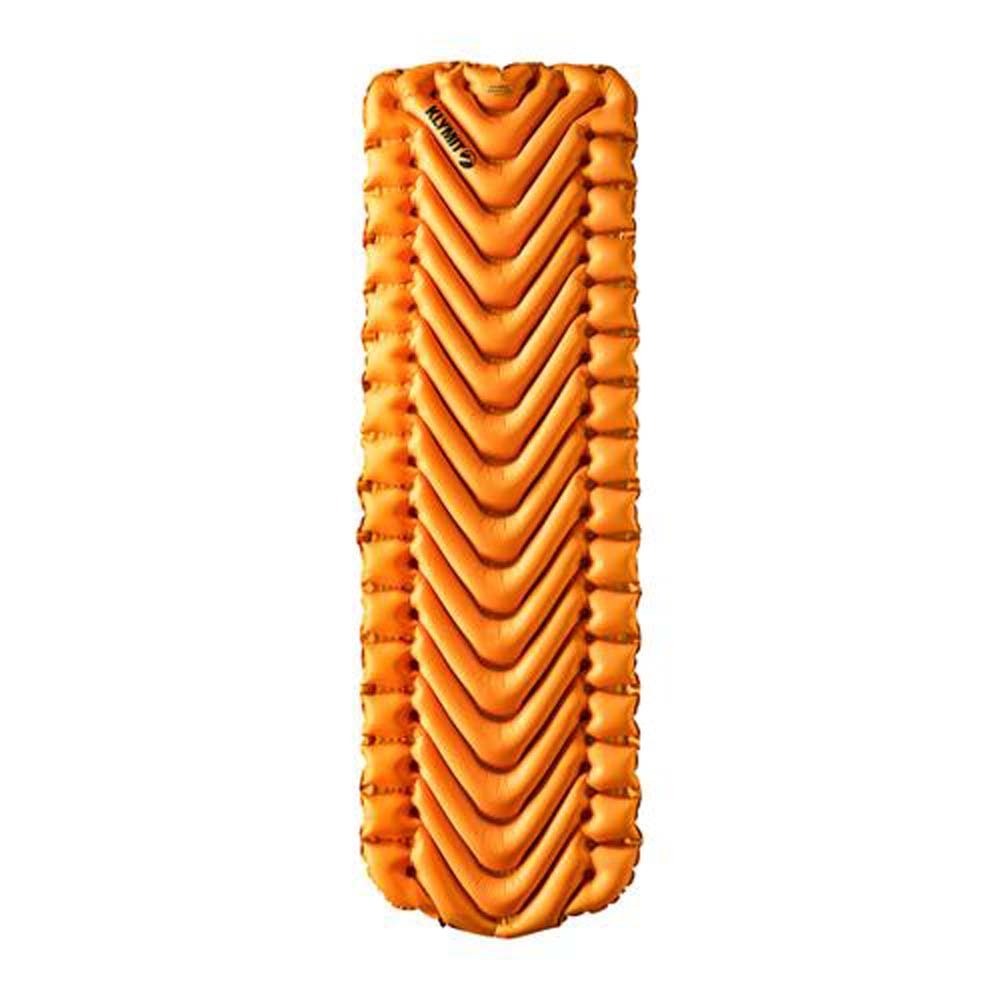
- Weight: 567 g (Regular)
- R-value: 4.4 (old standard; ASTM 1.9 new)
- Dimensions: 183 x 58 x 6 cm (Regular)
- Type: Inflatable V-chamber air pad (with Klymalite™ synthetic insulation)
Pros:
- Excellent warmth-to-weight (R4.4 old rating at 567g) – good for shoulder-season or mild winter camping.
- Patented V-chamber design with side rails keeps you from rolling off.
- Insulated chambers slow heat loss, boosting thermal efficiency.
- 6 cm thick, providing a stable sleep surface.
- Rapid inflation valve (compatible with included pump sack) and repair kit included.
Cons:
- Bulkier and heavier than minimalist summer pads.
- Can puncture like any inflatable (use a groundsheet).
- About $200 AUD, which is pricey for many hikers.
- New ASTM R-rating 1.9 (but still effectively R4 by older standard).
Best for: Year-round backpackers who need extra warmth and comfort. Its stability makes it ideal for side sleepers and back sleepers alike. It’s a versatile choice for camping in cool conditions.
The Klymit Insulated Static V Lite often shows up on ultralight gear lists thanks to its mix of warmth, comfort, and reasonable pack size.
Buy it here > Klymit Insulated Static V Lite
Thermarest NeoAir XLite Ultralight Insulated Sleeping Pad (Regular)
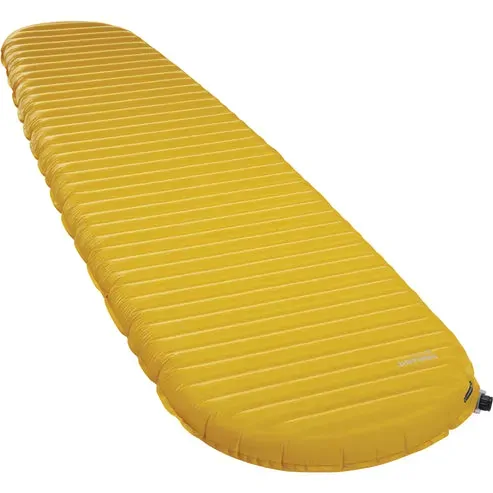
- Weight: ~370 g (Regular, 183×51×6 cm)
- R-value: 4.2 (4-season rating)
- Thickness: 6 cm (2.5 in)
- Type: Inflatable air pad (Triangular Core technology, ultralight design)
Pros:
- Excellent weight-to-warmth (R4.2 at ~370g).
- 6 cm thick for balance of comfort and packability.
- Very compact when packed (tiny valve & stuff sack).
- Quiet one-way valve and easy inflation.
- Widely used by thru-hikers and known for reliability.
Cons:
- Pricey for a pad; also noisy fabric on some models.
- Lower R-value means it’s not a winter pad by itself.
- Requires careful inflation/deflation and a repair patch.
Best for: Ultralight backpackers who hike year-round. The XLite is a top seller in Australia – many hikers carry it even into colder seasons, often pairing it with a thin foam mat. It’s best for 3-4 season use (spring/fall).
(OutdoorGearLab and reviewers often call the NeoAir XLite one of the best for weight savings and insulation.)
Buy it here > Thermarest NeoAir XLite Ultralight Insulated Sleeping Pad (Regular)
Thermarest NeoAir XTherm Lightweight Insulated Sleeping Pad (Regular)
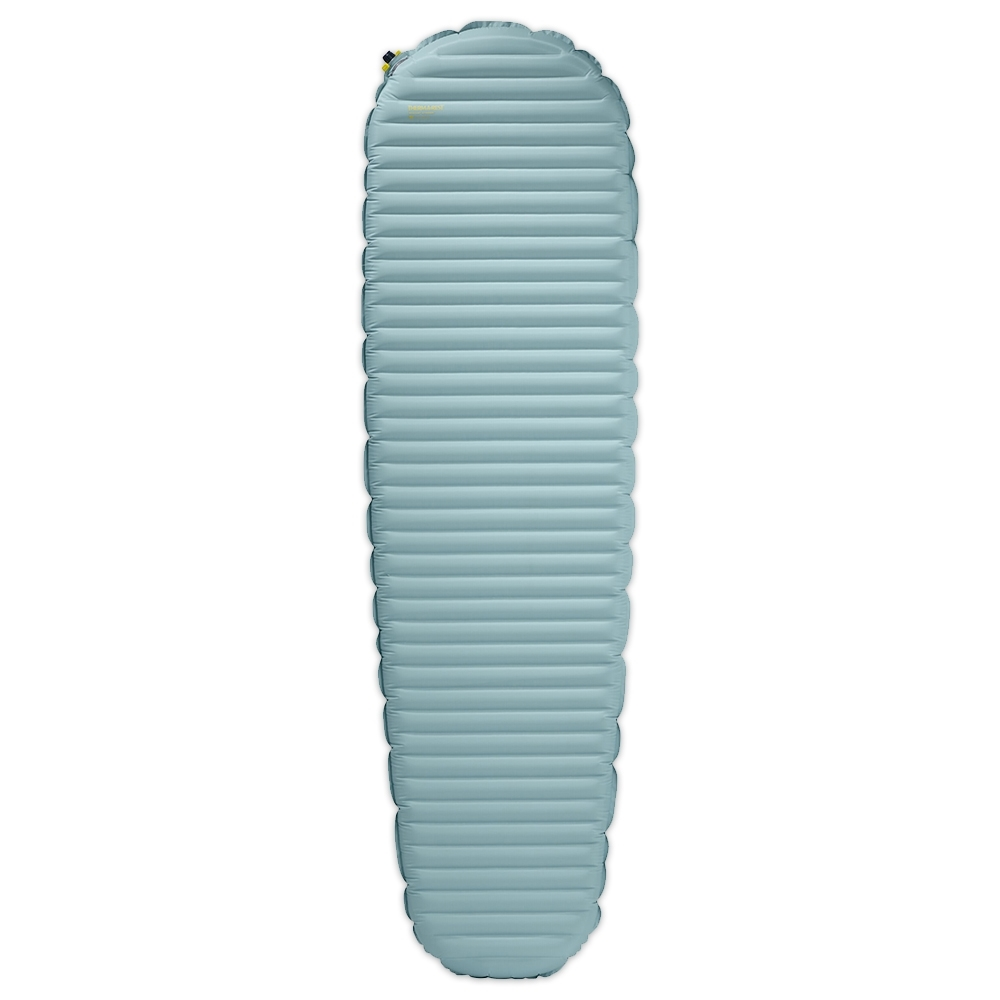
- Weight: 440 g (Regular)
- R-value: 7.3 (ASTM, extreme-warmth)
- Thickness: 7.6 cm (3 in)
- Type: Inflatable air pad (Triangular Core matrix + ThermaCapture reflective layer)
Pros:
- Best-in-class warmth-to-weight (R7.3 at only 440g).
- 3-inch thickness for comfort plus warmth.
- Thin 30D top fabric (with 70D bottom) – somewhat light yet durable.
- WingLock valve (fast inflate/deflate, easy fiddling with mittens).
Cons:
- Very expensive.
- Smooth surface – sleeping bag can slide on the pad.
- Less common in stock; may require online purchase.
Best for: Alpine climbers and cold-season trekkers in Australia. For bivvies in the Snowy Mountains or winter hikes, this pad is ideal. It’s the lightest pad you can use in sub-zero conditions.
Therm-a-Rest advertises XTherm as their warmest pad. Aussie outdoor retailers (like Snowys and Anaconda) often offer it in winter, making it the gold-standard extreme pad for freezing nights.
Buy it here > Thermarest NeoAir XTherm Lightweight Insulated Sleeping Pad (Regular)
Nemo Astro Insulated Sleeping Pad (Insulated Regular)
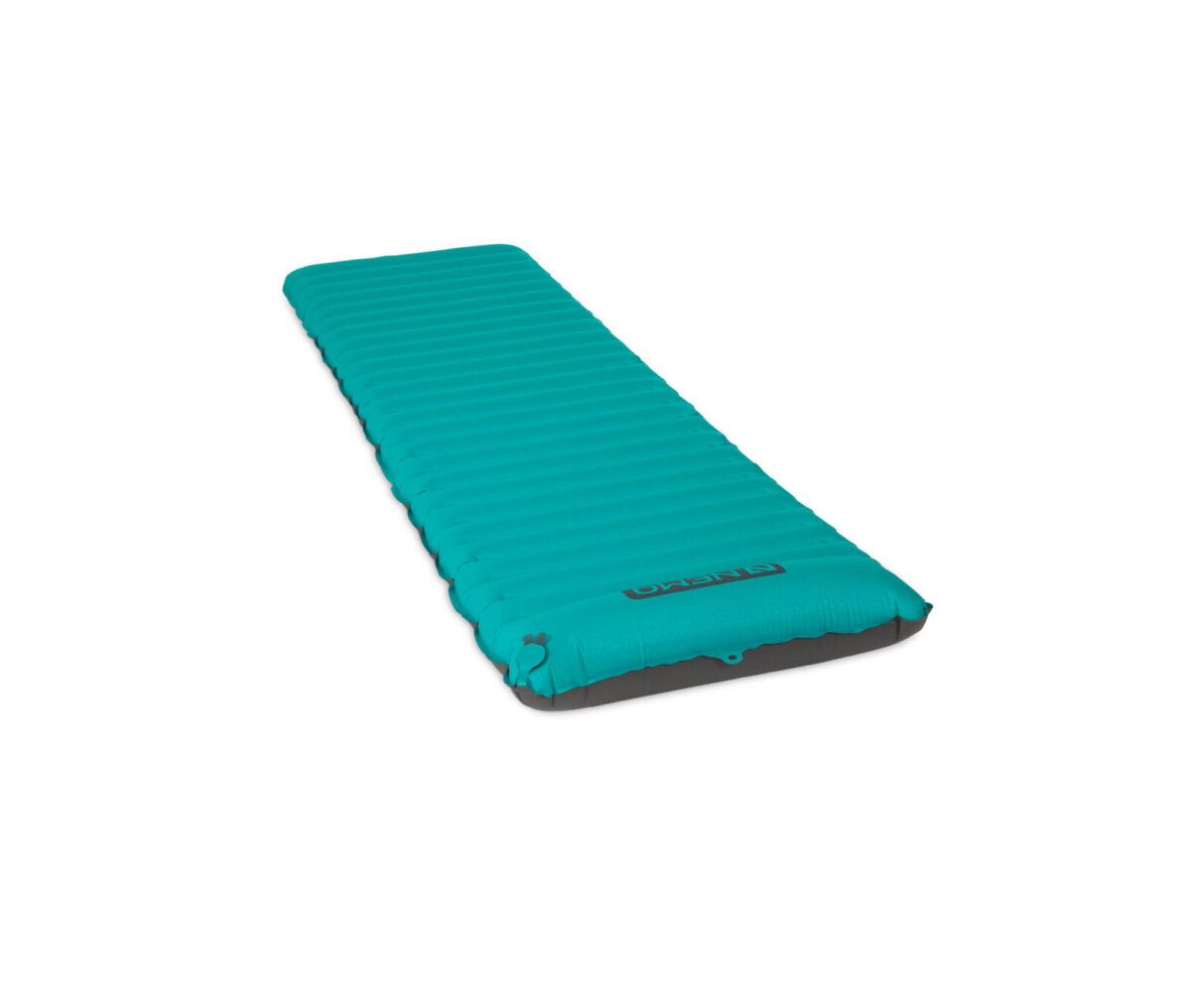
- Weight: 690 g (Regular)
- R-value: 2.6 (PrimaLoft insulation)
- Dimensions: 183 x 51 x 9 cm
- Type: Inflatable air pad (3.5″ plush, lateral baffles, integrated pillow baffle)
Pros:
- Very plush (3.5″ thick) – feels like a mattress.
- Lateral baffles provide stable comfort and prevent edges from curling.
- Pillow Baffle™ keeps your pillow in place and adds head support.
- Durable polyester shell (75D) and included pump sack for quick inflation.
- Decent insulation (R2.6) for 3-season camping.
Cons:
- Heavy and bulky (730g); not for backpacking.
- Low R-value (2.6) means it’s not a true winter pad.
- Expensive (though often clearance deals exist).
Best for: Campers seeking home-like comfort. Perfect for camping at Murphys Creek, or weekend bushwalks where you don’t mind extra weight. If you value comfort above all (especially side sleeping), the Astro delivers.
Buy it here > Nemo Astro Insulated Regular Sleeping Pad
Things to Consider When Buying a Sleeping Pad for Camping
R-value
A pad’s R-value measures how well it insulates you from cold ground. The higher the R-value, the more warmth. In warm summer camping near Brisbane, an R-value of 1–2 may suffice. But for autumn or winter trips, aim for R4 or higher (for example, the Nemo Tensor at R5.4 or the Ether Light XT Extreme at R6.2). Foam mats often have R~2, so many hikers layer a foam mat under an air pad for extra insulation. Always check the pad’s R-value vs expected temperatures, and remember: ground insulation + sleeping bag insulation = your warmth.
Type of Sleeping Mat
Sleeping pads come in two main categories: foam mats (closed-cell or self-inflating) and air mats. Closed-cell foam pads (like the Z-Lite or Switchback) are rugged (puncture-proof) and never leak, but they’re usually thicker and less insulating.
Air pads (self-inflating or inflatable) pack smaller and can achieve much higher R-values, but they require inflation (pump sack or breath) and can puncture.
Self-inflating mats mix foam and air (Sea to Summit SI).
Your camping style determines which to choose: foam is bulletproof and cheap, air is ultra-packable and very comfortable. Some hikers even use both (foam under an inflatable) for best insulation.
Comfort
Comfort factors include thickness and baffle design. Thicker pads (10 cm or more) offer much better cushioning, especially for side sleepers. Features like side rails or integrated pillows help too (as on the Nemo Astro. The pad’s width matters as well: wide mats give you room to move (or carry gear on the side). Also note surface texture – some pads have smooth tops (which some find slippery), others have fabric finish. Test inflation levels at home: a slightly under-inflated air pad can feel softer. Ultimately, pick the highest comfort you’re willing to carry.
Weight and Size
If you’re backpacking, weight and packed size are crucial. Ultralight air pads can weigh as little as 300–400 g and roll up very small; foam pads are light but large (e.g. foam Z-Lite just folds flat but is still 51×183 cm). Consider total weight: some pads include a pump sack, stuff sack, repair kit, which all add grams.
If you’re hiking light, prioritize ultralight inflatable mats. If car camping or bikepacking, you can afford a heavier, bulkier pad for more comfort. Always pack your pad last to gauge final pack size.
Additional Tips
- Inflation & Repair: Practice using the valve before your trip. Carry the included repair kit (patch or glue) for air pads.
- Tent Setup: Use a groundsheet or ensure site is clear to avoid punctures. Foam mats can sit directly on ground, air mats benefit from a footprint.
- Sleeping Bag Synergy: Remember your sleeping bag lofts better on a firm pad. Don’t rely on pad alone for insulation in cold weather – combine pad and bag R-values.
- Murphys Camping: Whether you’re backpacking or camping in the bush campground, choose a pad that suits local conditions. In Queensland’s winter nights you’ll appreciate R4+ pads, but summer there you might get by with just a thin inflatable or foam.
Sleep Better While Camping at Murphy’s Creek
From budget foam mats to high-tech inflatable mattresses, there’s a sleeping pad for every camper. We’ve reviewed some of the top pads in 2025, covering specs, pros and cons, and who they’re best for. By considering R-value, pad type, comfort, and weight/size, you can pick the right pad for your camping style.
When you’ve picked your perfect pad, plan a getaway to Murphys Creek Escape to try it out. Book your stay now and experience cozy nights under the stars on your ideal sleeping pad!

Jared Jeffery, the digital marketing specialist at Murphys Creek Escape, is a seasoned professional in the field of SEO-driven marketing. With over 10+ years of experience, he possesses a well-rounded background in the digital realm. Throughout his career, Jared has worked in agencies specializing in Travel, Finance, and Event Planning, lending his expertise to major projects involving prominent hotel chains. In addition, he has contributed his writing skills to the creation of numerous articles spanning across a wide range of industries. With his wealth of knowledge and extensive experience, Jared brings a valuable skill set to the table.
